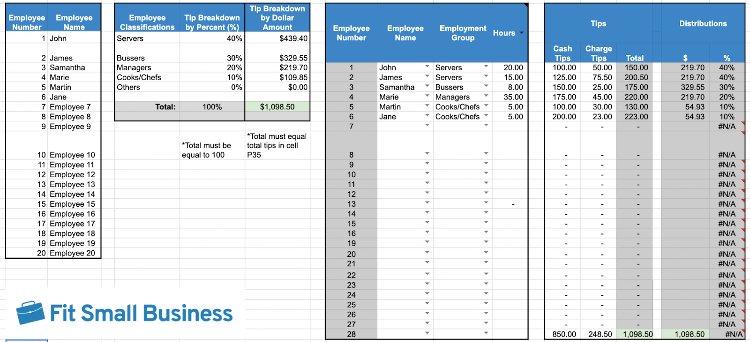Before implementing tip pooling in your restaurant, it’s important to completely understand what’s involved. Learn more about the practice, including applicable laws.
Restaurant Tip Pooling: Ultimate Guide (+ Free Template)
This article is part of a larger series on How to Do Payroll.
Tip pooling is when a portion or all of the tip money collected in a day is redistributed among tip-eligible employees, either evenly or by a set percentage. This practice can increase morale and is a great option for some restaurants. However, it’s important to implement correctly, as there are laws—like those forbidding management participation—that must be followed to avoid being fined.
As calculating tips using a tip pooling method can get confusing, I’ve provided a step-by-step guide to help you calculate tip distribution below, as well as a simple-to-use template that will help you divide your tips in a matter of minutes. Download it for free below.
How Tip Pooling Works
To understand tip pooling, you must have a firm grasp of the following key terms:
- Tip: According to the IRS, a tip is a voluntary amount of money left by a customer to pay workers for their service. It is money paid in addition to regular wages and is taxable if it exceeds $20 monthly.
- Tipped employees: As defined by the FLSA, they are those who customarily and regularly receive more than $30 per month in tips.
- Tip credit: Based on federal law, this amount is $5.12. This is the difference between the federal minimum wage ($7.25 per hour) and what employers are allowed to pay tipped employees ($2.13)—provided they receive enough tips to compensate for the difference. If the tips aren’t enough, the employer is required to pay the remainder.
There are many ways to handle tip pooling, the methods of which depend on what works best for your business. Generally, tipped employees collect all of the cash tips they receive throughout their shift and combine them with tips from each participating employee working the same shift. Once tips are totaled, the employer or employees divide them evenly among tip pool participants.
Tip Pooling Laws
There are a few federal and several state tip pooling laws to keep in mind. Violating these laws can come with reparations.
Common tip pooling violations employers make are:
- Including ineligible employees in a required tip pool
- Not paying employees all tips received.
Per the Department of Labor’s Fact Sheet, if you violate any federal tip pooling laws, you’ll have to pay the employees back for any tips they were owed but didn’t receive, tip credits claimed, and an additional amount for liquidated damages. If you also violate tip pooling laws at the state level, you’ll likely owe additional penalties.
Federal Tip Pooling Laws
Aside from who can participate in a tip pool, the DOL has other regulations you need to be aware of to protect you from liability. It’s important to remember that all tips (not service charges) belong to your employees.
Even when paid to your restaurant through a credit or debit card transaction, you’re prohibited from keeping any of the tips for yourself or your business. You’re also not allowed to pool and distribute them to any employees in a supervisory position.
Additionally, the revived 80/20 rule states that employers can utilize the tip credit as long as 80% or more of the work is tip-generating (providing table service, serving food, etc.), and not more than 20% is directly supporting work (setting tables, wiping down the bar, etc.).
State Tip Pooling Laws
Tip pooling laws vary widely by state. To check the tipped minimum wage and pooling laws that apply to yours, check out our state payroll guide directory and tipped minimum wage by state guide.
Some examples include:
- California: tip pooling is legal and all funds must be distributed equally; however, back-of-the-house employees are not included.
- Delaware: allows both voluntary and mandatory tip pooling; however, employees cannot contribute more than 15% of their tips.
- Massachusetts: only employees who directly provide service can be included in a tip pool.
- North Carolina: tip pooling is allowed, but employees must retain 85% of the tips earned before contributing to the pool.
- Utah: tip pooling is legal; however, employers must provide a written policy before establishing a pool.
The following states explicitly prohibit mandatory participation in tip pooling, but employees can participate voluntarily: Kentucky, Minnesota, Montana, and Wyoming.
Tip Pooling vs Tip Sharing
Most labor laws—including the FLSA—only use the term “tip pool”. But that doesn’t mean these laws don’t apply to tip sharing; the law simply doesn’t distinguish between the two terms. The difference between the two is a matter of restaurant operations. Tip pooling and tip sharing are just different ways to distribute communal tips among tipped restaurant employees.
- Tip share: Employees who process payments and collect the tips (servers, bartenders, etc.) retain their own tips and give a portion of their individual tips to the other staff that supported them (bussers, barbacks, etc.). Tip sharing is also called “tipping out,” and is the most common tip distribution arrangement in the restaurant industry. It can be voluntarily arranged by tipped employees or operate with tip-out percentages enforced by the restaurant.
- Tip pool: All of the collected tips for a shift are gathered in a single pot and distributed among all of the tipped employees based on a set percentage (as in the template included in this article). Tip pools are most common in fine dining restaurants and high-volume operations, where they help compensate all the tipped employees equally no matter what tasks they are assigned. Like a tip share, a tip pool can be voluntarily arranged by tipped employees or managed by the employer.
The DOL’s guidance states, “An employer that pays the full minimum wage and takes no tip credit may allow employees who are not tipped employees (for example, cooks and dishwashers) to participate in the tip pool.” Many states have laws that still don’t allow establishments to mandate tipped employees to share tips with BOH employees. It’s also important to note that for pooling to occur, all or a portion of employee tips must be totaled before distribution. Traditionally, many servers who shared tips with BOH employees did so out of their own individual tips—meaning they didn’t pool them.
It helps to understand the differences between, and the history of, tip pooling and tip sharing so that you’re not confused as new federal and state legislations are passed.
How to Calculate Tip Distributions
There’s no official guidance regarding how much servers should tip out, but it’s a good idea to have some sort of methodology behind your allocation. And, some states—like California—require employers that enforce a tip pool to provide employees with a written copy of the tip pool policy.
Tips that are not evenly distributed should be allocated based on job type. For example, a server should receive a higher percentage of the pooled tips. A sample tip pooling arrangement by percentages is as follows:
- Servers: 40%
- Runners: 30%
- Bussers: 20%
- Bar staff: 10%
Some states mandate that servers can only contribute a certain amount of their tips towards a tip pool. For example, in California and North Carolina servers can only contribute 15% of their tips. However, they should still be distributed 40% of the pooled tips.
To calculate a tip pool based on the above percentages follow these steps:
If you are creating a spreadsheet, it will be based on the list of employees and their job duties. Start by creating a list of all the employees who will be part of the tip pool.
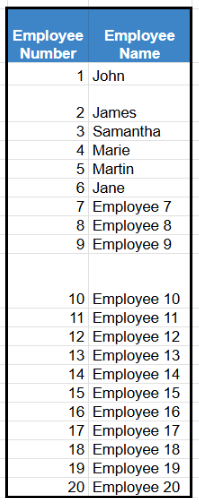
Create your list of employees.
Although the example shows first names only, I recommend you include both first and last names to properly identify each employee.
Start by entering the classification of each employee who will participate in the tip pool. For example, servers, runners, bussers, and bar staff. Next to each classification enter the tip breakdown by percent.
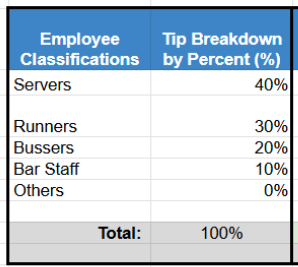
Determine the tip breakdown percentages based on employee classification.
Your total percentage of tip breakdown should equal 100%.
Calculate the total amount of all cash tips, plus all credit card transaction tips received during a specific timeframe (e.g., weekly).
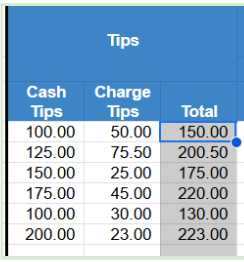
Calculate all the tips received in the required time period.
Using the total amount of all tips, multiply by the percentage required for each position type. In our example below, the total amount of tips is $1,098.50.
For a runner, the calculation is as follows: $1,098.50 × 30% = $329.55. Since this amount is distributed evenly among two employees (as shown in our example) they would each receive $164.78.
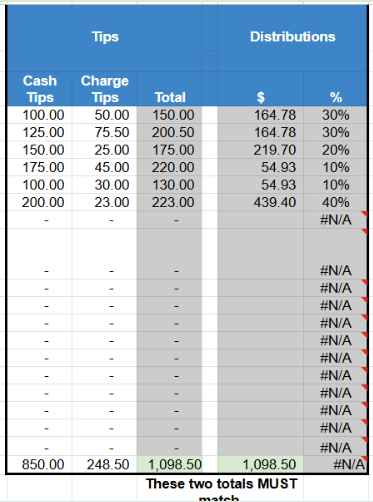
Run a formula in your spreadsheet to determine the total amount due to each employee based on their required percentage.
Based on the amounts calculated, add the tip amount per person to their next payroll, or distribute the cash.
Tips for Successful Tip Pooling Practices
Tip pooling doesn’t have to be complicated. By following these tips, you can ensure your employees understand the process and everyone is paid fairly.
- Notify employees: You must notify tipped employees of any required tip pool contribution amounts and to whom they will be redistributed before their participation. It’s a good idea to have a standard notice on hand to provide upon hiring.
- Don’t keep tips for the business or yourself: Employers are prohibited from retaining employees’ tips for any purpose other than verifying or processing them with the employees’ next paychecks. All tips are the property of the employees.
- Exclude managers and supervisors: Managers and supervisors are explicitly not allowed to participate in a tip pool under any circumstances.
- Require reasonable contribution amount: You can’t require employees to pay more into the tip pool than is customary and reasonable. In 2011, the DOL initially defined this as 15% of tips received or 2% of daily sales, but there are no hard rules as it hasn’t yet established a maximum contribution amount. Many restaurant employees pay above 15%.
Increase Wages for BOH Employees
If your goal is to even the income disparity between FOH staff (like servers) and BOH staff (like cooks), consider regularly increasing hourly wages for BOH employees. The pain point BOH workers feel is that their wages don’t fluctuate, which means they don’t rise like that of tipped staff. If you offer performance raises or bonuses, BOH employees are more apt to retain their motivation.
If you’re worried about how regular wage increases will affect your bottom line, consider taking advantage of the tip credit. Per federal law, you can pay tipped employees an hourly wage as low as $2.13 an hour as long as they receive enough tips (individually and in a valid tip pooling arrangement) to earn the $7.25 hourly minimum wage rate.
Just keep in mind that if you opt for the tip credit, you can’t revert to requiring FOH workers to pool or share tips with BOH employees—it must be optional. You’ll also need to check your local labor laws; some states or counties prohibit a sub-minimum tipped wage.
Educate Employees & Encourage Voluntary Tip Pooling
Mandatory tip pooling means you require your employees to pay their tips into a pool to be redistributed. Voluntary tip pooling is similar but is organized completely by the staff. They may ask you if you will help facilitate by distributing through payroll or counting and paying it out in cash, as you would automatically do if it was mandatory, and it’s your decision as to whether you’re willing to do so.
For this setup to be voluntary, you cannot have any say-so in how tips are collected or redistributed. When it comes to tips received electronically and by check, you have a say in how quickly you will pay them out (albeit the upcoming pay period is the latest you’re allowed to pay) because the tips are paid to your restaurant. You still don’t get to decide who gets what or how much.
In this scenario, you can still participate in the tip credit (if permitted by your local labor laws) and possibly be assured your BOH staff receives tips—if FOH employees decide to include them. The key to establishing a legal voluntary tip pooling arrangement is to ensure it’s adequately reflected that you didn’t coerce or force employees into the agreement. To avoid this, I recommend requesting that they sign a document to verify that their decision to establish a tip pooling arrangement was independent of you.
Alternatives to Mandatory Tip Pooling
To avoid the legal complexities associated with mandatory tip pooling, as well as some of the disadvantages, you should consider alternatives. First, determine why you want to implement a mandatory policy. Common reasons are to raise wages for BOH employees, ensure all tipped employees receive compensation for their service regardless of how well their customers tipped, and reduce bickering over certain customers.
Increase Wages for BOH Employees
If your goal is to even the income disparity between FOH staff (like servers) and BOH staff (like cooks), consider regularly increasing hourly wages for BOH employees. The pain point BOH workers feel is that their wages don’t fluctuate, which means they don’t rise like that of tipped staff. If you offer performance raises or bonuses, BOH employees are more apt to retain their motivation.
If you’re worried about how regular wage increases will affect your bottom line, consider taking advantage of the tip credit. Per federal law, you can pay tipped employees an hourly wage as low as $2.13 an hour as long as they receive enough tips (individually and in a valid tip pooling arrangement) to earn the $7.25 hourly minimum wage rate.
Just keep in mind that if you opt for the tip credit, you can’t revert to requiring FOH workers to pool or share tips with BOH employees—it must be optional. You’ll also need to check your local labor laws; some states or counties prohibit a sub-minimum tipped wage.
Educate Employees & Encourage Voluntary Tip Pooling
Mandatory tip pooling means you require your employees to pay their tips into a pool to be redistributed. Voluntary tip pooling is similar but is organized completely by the staff. They may ask you if you will help facilitate by distributing through payroll or counting and paying it out in cash, as you would automatically do if it was mandatory, and it’s your decision as to whether you’re willing to do so.
For this setup to be voluntary, you cannot have any say-so in how tips are collected or redistributed. When it comes to tips received electronically and by check, you have a say in how quickly you will pay them out (albeit the upcoming pay period is the latest you’re allowed to pay) because the tips are paid to your restaurant. You still don’t get to decide who gets what or how much.
In this scenario, you can still participate in the tip credit (if permitted by your local labor laws) and possibly be assured your BOH staff receives tips—if FOH employees decide to include them. The key to establishing a legal voluntary tip pooling arrangement is to ensure it’s adequately reflected that you didn’t coerce or force employees into the agreement. To avoid this, I recommend requesting that they sign a document to verify that their decision to establish a tip pooling arrangement was independent of you.
If you need help learning about other payroll regulations, check out our payroll compliance guide.
Tip Pooling Law Frequently Asked Questions (FAQs)
Tip pooling can be a great way to encourage teamwork, improve customer service, and ensure that tipped staff are compensated equitably. If you choose to establish a tip pool at your restaurant, though, it is important to make sure everyone in the pool is contributing to the work. Tensions can arise if your tipped employees feel that someone in the pool is not pulling their weight. If you do not have the managerial bandwidth to coach a high level of performance out of your entire team, a tip pool will likely frustrate your high-performing staff and could reduce sales.
There are several ways to calculate pooled tip distributions. You can distribute tips by percentage of the pool, by hours worked, or based on a points system.
Restaurants that run a tip pool typically do so to encourage teamwork and provide a higher level of customer service. When staff members work in a tip pool, they tend to have less tunnel vision on their assigned section while excluding the rest of the customers in the house. In a pooled house, everyone is earning a share of the tips from every table. So if a customer needs attention, it is in everyone’s best interest to help them, regardless of which restaurant section employees are currently assigned.
A restaurant can enforce a reasonable tip sharing or tip pooling arrangement as a condition of employment. Federal law only requires that the tip distribution is “reasonable” (though the law does not stipulate exactly what reasonable means). So, if a server or bartender chooses to withhold tips in violation of your restaurant’s reasonable tip share or tip pool policy, that could be a reason for dismissal.
Though the law is unclear on what would make a tip sharing policy unreasonable, restaurant owners or managers should take care that their tip share or tip pool policy is not too severe. If your tip out percentages are too high, you’ll likely lose high-performing staff who feel they can earn higher tips elsewhere.
In nearly every scenario, it is against the law for owners, managers, or supervisors to participate in tip pools or tip shares. However, there are some cases where managers may receive tips. The FLSA carves out an exception for tips that are given directly to managers for tasks that managers perform solely.
And in some states—like California—supervisors that do not have the ability to hire or fire staff, and who perform the same work as the employees they supervise (like coffee shop employees who are both supervisors and baristas) can be included in a tip pool.
